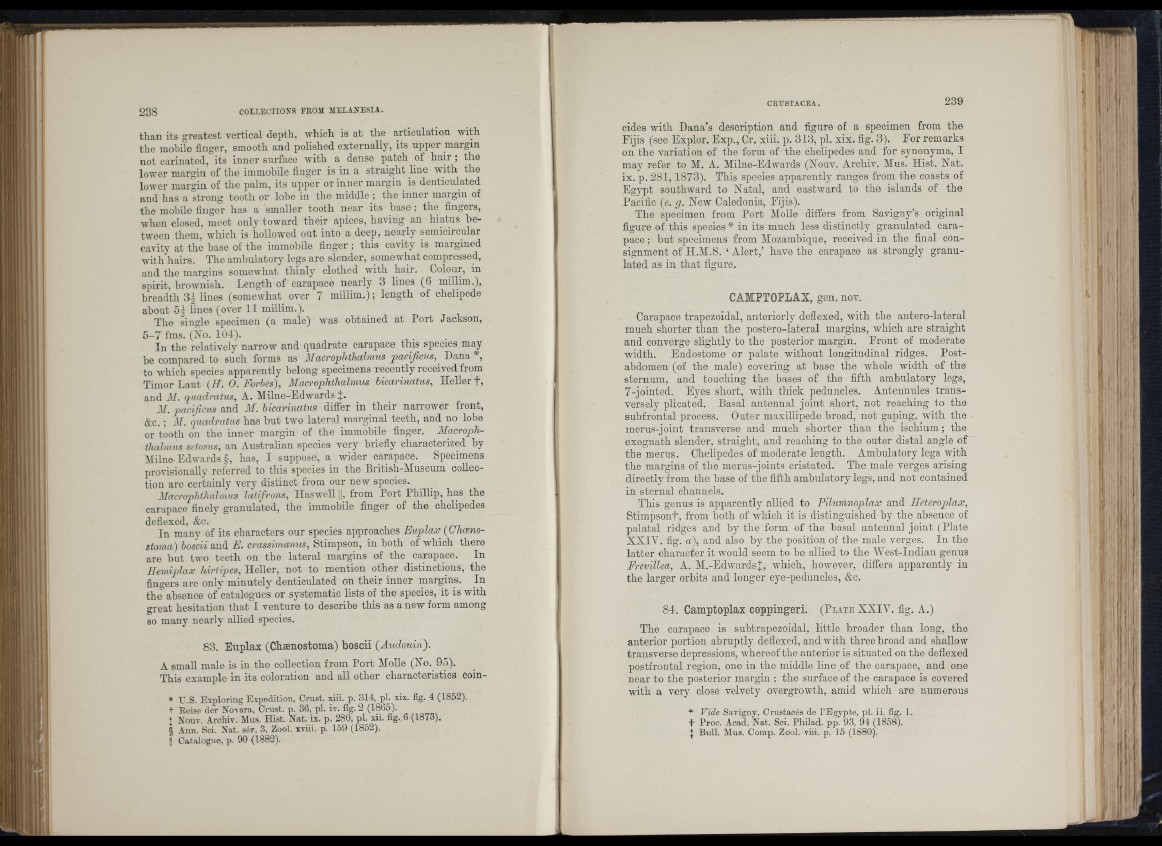
I
Mf3
. ?
L--i
I
i
238 COLLECTIONS FROM MELANESIA.
than its greatest vertical depth, which is at the articulation with
the mobile finger, smooth and polished externally, its upper margin
not carinated, its inner surface with a dense patch of hair ; the
lower margin of the immobile finger is in a straight line with tho
lower margin of the palm, its upper or inner margin_ is denticulated
and has a strong tooth or lobe in the middle ; tho inner margin of
the mobile finger has a smaller tooth near its base ; the fingers,
when closed, meet only toward their apices, having an hiatus between
them, which is hollowed out into a ,deep, nearly semicircular
cavity at the base of the immobile finger ; this cavity is margined
with hairs. The ambulatory legs are slender, somewhat compressed,
and the margins somewhat thinly clothed with hair. Colour, in
spirit, brownish. Length of carapace nearly 3 lines (6 millim.),
breadth 3 | lines (somewhat over 7 millim.); length of chelipede
about 5 | lines (over 11 millim.).
The single specimen (a male) was obtained at Port Jackson,
5 -7 fms. (No. 104).
In the relatively narrow and quadrate carapace this species may
be compared to such forms as Macrophthalmus pacificus, Dana *,
to which species apparently belong specimens recently received from
Timor Laiit {H. 0. Forhes), Alacrophthalmus bicarinatus, Heller f ,
and iii. quacZmit/s, A. Milne-Edwards j .
AI. pacificus and AI. bicarinatus differ in their narrower front,
&c. ; AI. quadratus has but two lateral marginal teeth, and no lobe
or tooth on the inner margin of the immobile finger. Alacroph-
thalmus setosus, an Australian species very briefly characterized by
Alilne-Edwards §, has, I suppose, a wider carapace. Specimens
provisionally referred to this species in tho British-Museum collection
are certainly very distinct from our new species.
AlacrophtJialmus latifrons, Haswell ||, from Port Phillip, has the
carapace finely granulated, the immobile finger of the chelipedes
deflexed, &c. _ , j. i rm
In many of its characters our species approaches lupLax^ (I/icenostoma)
boscii aud E. crassimanus, Stimpson, in both of which there
are but two teeth on the lateral margins of the carapace. In
Hemiplax hirtfies, Heller, not to mention other distinctions, the
fingers are only minutely denticulated on their inner margins. In
the absence of "catalogues or systematic lists of the species, it is with
great hesitation th at I venture to describe this as a new form among
so many nearly allied species.
83. Euplax (Chsenostoma) boscii (Audouin).
A small male is in the collection from Port Alolle (No.^ 95).
This example in its coloration and all other characteristics coin*
U.S. Exploring Expedition, Crust, xiii. p. 314, pi. xix. fig. 4 (1852).
t Reise der Novara, Crust, p. 36, pi. iv. fig. 2 (1865).
+ Nouv. Archiv. Mus. Hist. Nat. ix. p. 280, pi. xn. fig. 6 (1873).
§ Ann. Sci. Nat. sér. 3, Zool. xviii. p. 159 (1852).
J Catalogue, p. 90 (1882).
239
cides with Dana’s description and figure of a specimen from the
Eijis (see Explor. Exp., Cr. xiii. p. 313, pi. xix. fig. 3). Eor remarks
on the variation of the form of the chelipedes and for synonyma, I
may refer to AI. A. Alilne-Edwards (Nouv. Archiv. AIus. Hist. Nat.
ix. p. 281,1873). This species apparently ranges from the coasts of
Egypt southward to Natal, and eastward to the islands of the
Pacific (e. CJ. New Caledonia, Eijis).
The specimen from Port Alolle differs from Savigny’s original
figure of this species * in its much less distinctly granulated carapace
; but specimens from Alozamhique, received in the final consignment
of H.Al.S. ‘ Alert,’ have the carapace as strongly granulated
as in th at figure.
CAMPTOPLAX, gen. nov.
Carapace trapezoidal, anteriorly deflexed, with the antero-lateral
much shorter than the postero-lateral margins, which are straight
and converge slightly to the posterior margin. Eront of moderate
width. Endostome or palate without longitudinal ridges. Postabdomen
(of the male) covering at base the whole width of the
sternum, and touching the bases of the fifth ambulatory legs,
7-jointed. Eyes short, with thick peduncles. Antennules transversely
plicated. Basal antennal joint short, not reaching to the
subfrontal process. Outer maxillipede broad, not gaping, with the
merus-joint transverse and much shorter than the ischium; the
exognath slender, straight, and reaching to the outer distal angle of
the merus. Chelipedes of moderate length. Ambulatory legs with
the margins of the merus-joints cristated. The male verges arising
directly from the base of the fifth ambulatory legs, and not contained
in sternal channels.
This genus is apparently allied to Pilumnoplax and Ileteroplax,
Stimpsont, from both of which it is distinguished by the absence of
palatal ridges and by the form of the basal antennal joint (Plate
XXIV. fig. a), and also by the position of the male verges. In the
latter character it would seem to be allied to the AVest-Indian genus
Frevillea, A. AI.-EdwardsJ, which, however, differs apparently in
the larger orbits and longer eye-peduncles, &c.
84. Camptoplax coppingeri. (P late XXIV. fig. A.)
The carapace is suhtrapezoidal, little broader than long, the
anterior portion abruptly deflexed, and with three broad and shallow
transverse depressions, whereof the anterior is situated on the deflexed
postfrontal region, one in the middle line of the carapace, and one
near to the posterior margin ; the surface of the carapace is covered
with a very close velvety overgrowth, amid which are numerous
* Vide Savigny, Crustacés de l’Egypte, pl. ii. fig. 1.
t Proc. Acad. Nat. Sci. Philad. pp. 93, 94 (1858).
i Bull. Mus. Corap. Zool. viii. p. 15 (1880).
‘ Y ' i
ii "
S i : il
:!-■
n
-1 * I
I , T ‘ '
-P i
i: ifi J
h
4 i i 4
Í .Û,ri
i I '
M . •
' î? ' i